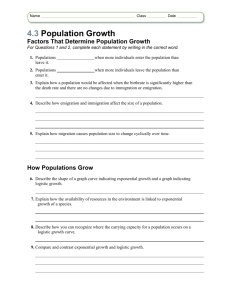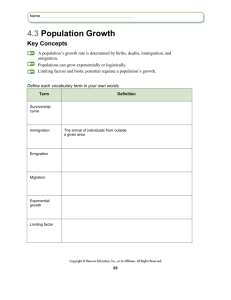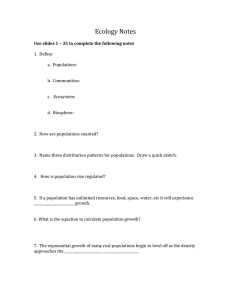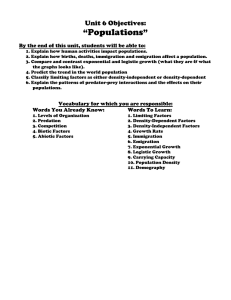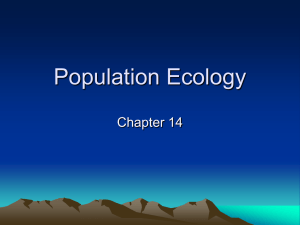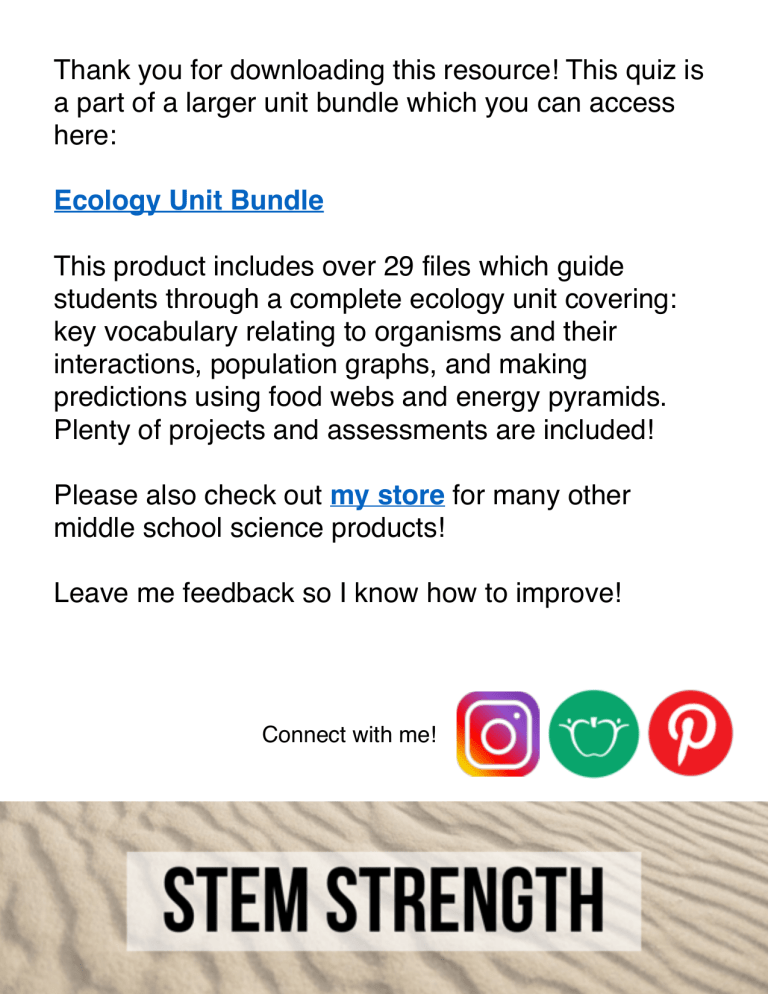
Thank you for downloading this resource! This quiz is a part of a larger unit bundle which you can access here: Ecology Unit Bundle This product includes over 29 files which guide students through a complete ecology unit covering: key vocabulary relating to organisms and their interactions, population graphs, and making predictions using food webs and energy pyramids. Plenty of projects and assessments are included! Please also check out my store for many other middle school science products! Leave me feedback so I know how to improve! Connect with me! Ecology Quiz – Version A Name: ______________ 1. Plants are an example of A. A biotic factor B. An abiotic factor C. An ecosystem D. Immigration 2. Put in the correct order: A. Populations make up ecosystems which make up communities which make up organisms B. Organisms make up communities which make up populations which make up ecosystems C. Organisms make up populations which make up communities which make up ecosystems D. Populations make up communities which make up ecosystems which make up organisms 3. Circle all the ways that a population can change A. Births B. Deaths C. Emigration D. Immigration 4. The population density is the size of the population in a certain ________. A. Space B. City C. Year D. Time of day 5. What is a limiting factor? A. Something that allows a population to continue to grow B. Something that runs out first C. Something that makes a species unique D. Something necessary for survival 6. What is carrying capacity? A. The temperature at which water boils B. All of the biotic and abiotic factors in an ecosystem C. The combined death rate and birth rate of a population D. The maximum number of individuals an area can support 7. In the graph to the right, which curve represents a species in which most individuals survive their entire lives and die at an older age. A. Type I B. Type II C. Type III D. None of these 8. Fish lay thousands of eggs at one time, knowing that most of their offspring will not survive. This is an example of A. Big Bang Reproduction B. Repeated reproduction C. Carrying Capacity D. Emigration ©STEM Strength 9. Which is an example of an adaptation A. A koala eats only eucalyptus leaves, and will die if they run out B. As a wolf population increases, the moose population decreases C. An unusually cold winter causes the squirrel population to decrease D. Sharks migrate to warmer waters in the winter 10. What is a niche? A. The maximum number of individuals an area can support B. A physical or behavioral change which allows a species to be more competitive C. A species’ unique place in its ecosystem D. A species which eats only plants 11. Why does an energy pyramid get smaller as you move toward the top? A. More animals have been eaten B. Less energy is available as it has been used for living C. Populations are more affected by temperature changes D. Populations are larger 12. A relationship where two organisms live closely and affect one another is called A. Niche B. Limiting Factor C. Adaptation D. Symbiosis 13. Which is an example of commensalism? A. Mosquitoes suck the blood of living creatures, causing itchy bumps B. Hummingbirds get food from flowers and help them by pollinating them C. Remora fish ride along on the belly of a shark and eat its scraps without bothering it D. Trees provide oxygen for animals and animals provide carbon dioxide for trees 14. Only _________ can use the energy of the sun to make food A. Consumers B. Producers C. Decomposers D. Herbivores 15. Which is an organism which eats only plants? A. Herbivore B. Producer C. Omnivore D. Scavenger 16. Which organism in the food web represents a secondary consumer? A. Grasshopper B. Deer C. Squirrel D. Bird 17. Which species below is a predator? A. Squirrel B. Shark C. Maple tree D. Hummingbird ©STEM Strength Ecology Quiz – Version B Name: ______________ 1. The sun is an example of A. A biotic factor B. An abiotic factor C. An organism D. Symbiotic Factor 2. Ecosystems are made up of A. All the living things in an area B. All the living things of the same species in an area C. All the living and nonliving things in an area D. None of these 3. Circle all the ways that a population can increase A. Births B. Deaths C. Emigration D. Immigration 4. What is carrying capacity? A. The temperature at which water boils B. All of the biotic and abiotic factors in an ecosystem C. The combined death rate and birth rate of a population D. The maximum number of individuals an area can support 5. The population density is the size of the population in a certain ________. A. Space B. City C. Year D. Time of day 6. Why does an energy pyramid get smaller as you move toward the top? A. More animals have been eaten B. Less energy is available as it has been used for living C. Populations are more affected by temperature changes D. Populations are larger 7. In the graph to the right, which curve represents a species in which most individuals survive their entire lives and die at an older age. A. Type I B. Type II C. Type III D. None of these 8. Spiders lay thousands of eggs at one time, knowing that most of their offspring will not survive. This is an example of A. Repeated reproduction B. Carrying Capacity C. Big Bang Reproduction D. Emigration ©STEM Strength 9. What is a limiting factor? A. Something that allows a population to continue to grow B. Something that runs out first C. Something that makes a species unique D. Something necessary for survival 10. What is a niche? A. The maximum number of individuals an area can support B. A physical or behavioral change which allows a species to be more competitive C. A species’ unique place in its ecosystem D. A species which eats only plants 11. A relationship where two organisms live closely and affect one another is called A. Niche B. Limiting Factor C. Adaptation D. Symbiosis 12. Which is an example of an adaptation A. A koala eats only eucalyptus leaves, and will die if they run out B. As a wolf population increases, the moose population decreases C. An unusually cold winter causes the squirrel population to decrease D. Sharks migrate to warmer waters in the winter 13. Which is an example of commensalism? A. Mosquitoes suck the blood of living creatures, causing itchy bumps B. Hummingbirds get food from flowers and help them by pollinating them C. Remora fish ride along on the belly of a shark and eat its scraps without bothering it D. Trees provide oxygen for animals and animals provide carbon dioxide for trees 14. _________ must eat in order to get their energy A. Consumers B. Producers C. Algae D. Plants 15. Which is an organism which eats only animals? A. Herbivore B. Producer C. Omnivore D. Carnivore 16. Which organism in the food web represents a primary consumer? A. Grasshopper B. Owl C. Fox D. Bird 17. Which species below is a prey? A. Owl B. Shark C. Snake D. Grasshopper ©STEM Strength Ecology Quiz – Version C Name: ______________ 1. The population density is the size of the population in a certain ________. A. Space B. City C. Year D. Time of day 2. Which of the following is an abiotic factor (circle all that apply) A. Rainfall B. Grass C. Temperature D. The sun 1. Communities are made up of A. All the living things in an area B. All the living things of the same species in an area C. All the living and nonliving things in an area D. None of these 2. Immigration is when A. New individuals are born B. Individuals die C. Individuals move into an area D. Individuals move out of an area 1. What is a limiting factor? A. Something that allows a population to continue to grow B. Something that runs out first C. Something that makes a species unique D. Something necessary for survival 2. The maximum number of individuals that a population can support is known as? A. Biotic Factor B. Carrying capacity C. Limiting Factor D. Ecology 7. In the graph to the right, which curve represents a species in which individuals are equally likely to die at every age A. Type I B. Type II C. Type III D. None of these 8. Elephants have only one baby every couple of years, and spend a lot of time raising their offspring. This is an example of A. Big Bang Reproduction B. Repeated reproduction C. Carrying Capacity D. Emigration ©STEM Strength 9. A relationship where two organisms live closely and affect one another is called A. Limiting Factor B. Adaptation C. Niche D. Symbiosis 10. Which is an example of an adaptation A. A koala eats only eucalyptus leaves, and will die if they run out B. As a wolf population increases, the moose population decreases C. An unusually cold winter causes the squirrel population to decrease D. Sharks migrate to warmer waters in the winter 11. What is a niche? A. The maximum number of individuals an area can support B. A physical or behavioral change which allows a species to be more competitive C. A species’ unique place in its ecosystem D. A species which eats only plants 12. Why does an energy pyramid get smaller as you move toward the top? A. More animals have been eaten B. Less energy is available as it has been used for living C. Populations are more affected by temperature changes D. Populations are larger 13. Which is an example of parasitism? A. Mosquitoes suck the blood of living creatures, causing itchy bumps B. Hummingbirds get food from flowers and help them by pollinating them C. Remora fish ride along on the belly of a shark and eat its scraps without bothering it D. Trees provide oxygen for animals and animals provide carbon dioxide for trees 14. _________ break down dead and decaying matter for the ecosystem A. Consumers B. Producers C. Decomposers D. Herbivores 15. Which is an organism which eats plants and animals? A. Herbivore B. Producer C. Omnivore D. Scavenger 16. Which organism in the food web represents a tertiary consumer? A. Elephant Seal B. Krill C. Protists and Small Animals D. Algae 17. Which species below is a producer? A. Algae B. Cod C. Protists and small animals D. Krill ©STEM Strength Ecology Quiz – Version D Name: ______________ 1. Which of the following is a biotic factor? (Circle all that apply) A. The sun B. Fish C. Oxygen D. Plants 2. Populations are made up of: A. All the living things in an area B. All the living things of the same species in an area C. All the living and nonliving things in an area D. None of these 3. Emigration is when A. New individuals are born B. Individuals die C. Individuals move into an area D. Individuals move out of an area 4. A factor that limits population growth is called a A. Immigration B. Carrying capacity C. Symbiosis D. Limiting Factor 5. The maximum number of individuals that a population can support is known as? A. Biotic Factor B. Carrying capacity C. Limiting Factor D. Ecology 6. A relationship where two organisms live closely and affect one another is called A. Niche B. Limiting Factor C. Adaptation D. Symbiosis 7. In the graph to the right, which curve represents a species in which most individuals die at a young age and very few live to an old age. A. Type I B. Type II C. Type III D. None of these 8. Whales have only one baby every couple of years, and spend a lot of time raising their offspring. This is an example of A. Repeated reproduction B. Carrying Capacity C. Emigration D. Big Bang Reproduction ©STEM Strength 9. The population density is the size of the population in a certain ________. A. Space B. City C. Year D. Time of day 10. Which is an example of an adaptation A. A koala eats only eucalyptus leaves, and will die if they run out B. As a wolf population increases, the moose population decreases C. An unusually cold winter causes the squirrel population to decrease D. Sharks migrate to warmer waters in the winter 11. What is a niche? A. The maximum number of individuals an area can support B. A physical or behavioral change which allows a species to be more competitive C. A species’ unique place in its ecosystem D. A species which eats only plants 12. Why does an energy pyramid get smaller as you move toward the top? A. More animals have been eaten B. Less energy is available as it has been used for living C. Populations are more affected by temperature changes D. Populations are larger 13. Which is an example of mutualism? A. Mosquitoes suck the blood of living creatures, causing itchy bumps B. Bears hunt salmon C. Remora fish ride along on the belly of a shark and eat its scraps without bothering it D. Trees provide oxygen for animals and animals provide carbon dioxide for trees 14. Only _________ can use the energy of the sun to make food A. Consumers B. Decomposers C. Herbivores D. Producers 15. Which is an organism which eats plants and animals? A. Herbivore B. Producer C. Omnivore D. Scavenger 16. Which organism in the food web represents a quaternary consumer? A. Krill B. Protists and Small Animals C. Algae D. Killer whale 17. Which species below is a producer? A. Algae B. Cod C. Protists and small animals D. Krill ©STEM Strength Form A 1. A 2. C 3. A,B,C,D 4. A 5. B 6. D 7. A 8. A 9. D 10. C 11. B 12. D,A 13. D 14. A 15. B 16. A 17. A Form C 1. A 2. D 3. A 4. C 5. B 6. B 7. B 8. B 9. D 10. D 11. C 12. B 13. A 14. C 15. C 16. A Form B 1. B 2. C 3. D,A 4. D 5. A 6. B 7. A 8. A 9. B 10. C 11. D 12. D 13. C 14. A 15. D 16. A 17. D Form D 1. B,D 2. B 3. D 4. D 5. B 6. D 7. C 8. A 9. A 10. D 11. C 12. B 13. D 14. D 15. C 16. D NAME: ___________ NAME: ___________ NAME: ___________ NAME: ___________ Form: ____ Form: ____ Form: ____ Form: ____ 1. ____ 1. ____ 1. ____ 1. ____ 2. ____ 2. ____ 2. ____ 2. ____ 3. ____ 3. ____ 3. ____ 3. ____ 4. ____ 4. ____ 4. ____ 4. ____ 5. ____ 5. ____ 5. ____ 5. ____ 6. ____ 6. ____ 6. ____ 6. ____ 7. ____ 7. ____ 7. ____ 7. ____ 8. ____ 8. ____ 8. ____ 8. ____ 9. ____ 9. ____ 9. ____ 9. ____ 10. ____ 10. ____ 10. ____ 10. ____ 11. ____ 11. ____ 11. ____ 11. ____ 12. ____ 12. ____ 12. ____ 12. ____ 13. ____ 13. ____ 13. ____ 13. ____ 14. ____ 14. ____ 14. ____ 14. ____ 15. ____ 15. ____ 15. ____ 15. ____ 16. ____ 16. ____ 16. ____ 16. ____ 17. ____ 17. ____ 17. ____ 17. ____
